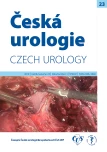Correlation of expression of Ki-67, MCM2, MCM5 and p53 in tissue specimens and cell blocks in patients with urothelial carcinoma
Authors:
Jaromír Háček 1; Antonín Brisuda 2; Marcela Čechová 2; Marek Babjuk 2
Authors‘ workplace:
Ústav patologie a molekulární medicíny 2. LF UK a FN Motol, Praha
1; Urologická klinika 2. LF UK v FN Motol, Praha
2
Published in:
Ces Urol 2019; 23(1): 36-42
Category:
Original Articles
Overview
Major statement: The study deals with im‑munocytochemistry as an additional method to urinary cytology examination. We present the correlation of selected immunochemical markers expression in tissues and cell blocks in patients with urinary bladder urothelial carcinoma.
Aim: The aim of the study is to verify whether expression of selected immunochemical markers in tumor tissue of patients with urinary bladder urothelial carcinoma correlates with expression in cytology (cell block) material.
Material and methods: In 77 patients (25 with low‑grade urothelial carcinoma, 52 with high‑grade carcinoma) we performed the immu‑nochemical examination of Ki-67, MCM2, MCM5 and p53 markers in tumor tissues and cell blocks from urine collected before surgical resection. Thereafter we correlated the expression rate of each marker in tissue specimen and cell block in every patient.
Results: There were significant differences in expression of all examined markers between low ‑grade and high‑grade urothalial carcinomas in tissue specimens and cell blocks. Expression of all markers in tissue specimens correlated with expression in cell blocks.
Conclusion: Immunocytochemical exami‑nation of material retrieved from cell block with adequate cellularity has similar value as immuno‑histochemical examination of tumor tissue.
Keywords:
Immunocytochemistry – urine cytology – urothelial carcinoma
Sources
- Ondič O, Slunéčko R, Švadler M ml. Postavenie a význam cytológie moča v diagnostike uroteliálnych nádorov. Cesk Patol 2014; 50(4): 142–145.
- Yafi FA, Brimo F, Steinberg J, et al. Prospective analysis of sensitivity and specificity of urinary cytology and other urinary biomarkers for bladder cancer. Urol Oncol 2015; 33(2): 66.e25–31.
- Yafi FA, Brimo F, Auger M, et al. Is the performance of urinary cytology as high as reported historically? A contemporary analysis in the detection and surveillance of bladder cancer. Urol Oncol 2013; 32: e1–6.
- Rosenthal DL, Wojcik EM, Kurtycz DFI. The Paris system for reporting urinary cytology. Switzerland Springer; 2016.
- Luthra UK, Dey P, George J. Comparison of ThinPrep and conventional preparations: urine cytology evaluation. Diagn Cytopathol 1999; 21 : 364–366.
- Nassar H, Ali‑Fehmi R, Madan S. Use of ThinPrep monolayer technique and cytospin preparation in urine cytology: a comparative analysis. Diagn Cytopathol 2003; 28 : 115–118.
- Piaton E, Faynel J, Hutin K, Ranchin MC, Cottier M. Conventional liquid‑based techniques versus Cytyc Thinprep processing of urinary samples: a qualitative approach. BMC Clin Pathol 2005; 5 : 9.
- Böhm M, Schostak M, Hakenberg OW. Urinary immunocytology – promise or nonseller? A review with an opinion. Urol Oncol 2014; 32(4): 383–390.
- Brisuda A, Háček J, Čechová M, Škapa P, Babjuk M. Clinical and cytopathological factors affecting the cellularity of urinary cell blocks and the implication for the diagnosis and follow‑up of the urinary bladder urothelial carcinoma. Cytopathology 2018; 6. doi: 10.1111/cyt.12580.
- Courtade‑Saïdi M, Aziza J, d‚Aure D, et al. Immunocytochemical staining for p53 and Ki-67 helps to characterise urothelial cells in urine cytology. Cytopathology 2016; 27(6): 456–464.
- Kelly JD, Dudderidge TJ, Wollenschlaeger A, et al. Bladder cancer diagnosis and identification of clinically significant disease by combined urinary detection of Mcm5 and nuclear matrix protein 22. PLoS One 2012; 7(7): e40305.
- Saeb‑Parsy K, Wilson A, Scarpini C, et al. Diagnosis of bladder cancer by immunocytochemical detection of minichromosome maintenance protein-2 in cells retrieved from urine. Br J Cancer 2012; 107(8): 1384–1391.
- Burger M, Denzinger S, Hartmann A, et al. Mcm2 predicts recurrence hazard in stage Ta/T1 bladder cancer more accurately than CK20, Ki67 and histological grade. Br J Cancer 2007; 96(11): 1711–1715.
- Hainaut P, Hernandez T, Robinson A, et al. IARC database of p53 gene mutations in human tumors and cell lines: Updated compilation, revised formats, and new visualization tools. Nucleic Acids Res 1998; 26 : 205–213.
- Moch H, Humphrey PA, Ulbright TM, Reuter VE. WHO classification of tumours of the urinary system and male genital organs. Lyon: IARC; 2016.
- Bastacky S, Ibrahim S, Wilczynski SP, Murphy WM. The accuracy of urinary cytology in daily practice. Cancer 1999; 87(3): 118–128.
- Saqi A. The state of cell blocks and ancillary testing: past, present and future. Arch Pathol Lab Med 2016; 140(12): 1318–1322.
- Barkan GA. Enough is enough: adequacy of voided urine cytology. Cancer Cytopathol 2016; 124(3): 163–166.
Labels
Paediatric urologist Nephrology UrologyArticle was published in
Czech Urology

2019 Issue 1
Most read in this issue
- Endometriosis of the bladder as a cause of iatrogenic bladder perforation
- Use of PSA density and multiparametric MRI for indication of prostate biopsy
- A urologists view of hematuria in pediatric patients
- Diagnosis, therapy and urological complications of cloacal malformations
